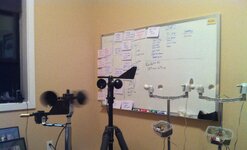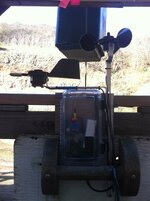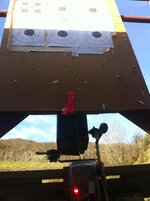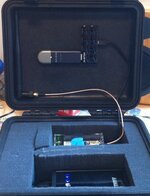Southern Lights
WKR
Back in 2011-2012 I designed and prototyped a wireless mesh wind meter system designed to be used on rifle ranges. The idea was to place wind meters at the shooting position, mid-range, and at the target. Then these would send data back to the firing line where you could connect via wifi to the system with your phone and see real-time wind values of each station along with averages.
The idea was whether I could use this system to help train shooters to read the wind. I tested it with the US F-Class rifle team, a well-known LR rifle school, plus extensive field testing on my own.
I also presented the idea to Applied Ballistics, but unfortunately I didn’t think it could be commercialized economically and the wind meters would be far too fragile for the kind of handling they’d likely get in the field. Spinning anemometers are fragile and don’t like being tossed around. At the time ultrasonic sensors were just as fragile and extremely expensive. I abandoned the project.
Perhaps today the new Calypso ultrasonic sensors can be meshed together and make something affordable and reliable. It may be helpful for training on known ranges and stable winds, but not sure how useful it would be in practice when those skills were taken out in broken terrain and unknown ranges.
I found the photos recently and thought I’d share them here in case people were interested. I also learned a lot about reading wind when doing this. Some of my lessons:
1) The wind at ground level is much different than 5, 10, 15, 20ft. higher. The grass and brush causes massive disturbance and turbulence slowing down and impacting wind direction. If you are pulling your kestrel out when lying prone, you should stand up at least.
2) The wind speed at max-ordinate (mid trajectory) is often much different than where you are. Again it’s much higher than ground level. If you are shooting across a valley you probably have no real idea what it may be doing outside a WAG. Don’t fool yourself.
3) The wind difference at ground level was so much different I had considered shipping the system with light rigging tripods that could get the meters 20-30ft. above ground just to be more accurate.
4) The wind moving downrange can vary drastically and quickly between when you decide to pull the trigger, when the bullet ignites, and when it gets to target.
5) There is a huge difference between shooting F-Class or banging steel where you had lots of sighters, and a cold bore single shot must hit hunting situation. A lot of people say stuff like: “I was center punching the plate for 10 times in row!” But what they forgot to mention were the five shots they took to walk that bullet on target.
6) You can be pretty sloppy out to 400y and still do OK with basic wind skills outside of strong winds. From 400-600 you need to be very careful about wind and technique. Past 600 things go south really fast and I'd avoid taking shots on animals at those ranges even if you are well-practiced.
7) Shooting unknown terrain on broken ground in hunting conditions and calling accurate wind is vastly more difficult than people think. It's a black art with far more luck involved than people admit.
8) Don’t believe anything you see on YouTube or from various marketing departments about taking long shots on animals. A lot of it is edited and mis-representing the actual difficulty. I was very deep into this problem and saw the reality with actual wind data.
Learning to read wind is a combination of really knowing your bullet and shooting in various conditions to build an intuitive sense of how it affects things. The better shooters seemed to really focus on objects moving in the environment downrange, as well as how the wind just felt on them at their position. Lay of the land and how the wind moves over it they also considered.
I shot with one guy in F-Class that was on a national rifle team overseas. One time, he was actually using the movement of a hawk above the target riding thermals to help read the wind because he didn't see anything else telling him what was going on. He hit the X. Some shooters just have a really good skill they've developed. But again, even they made windcall blunders.
People like Backfire TV and Eric Cortina are doing great work with their hunter challenges and exposing how hard it is to even hit things consistently in the field at 300 yards for many hunters. Even well trained shooters miss these shots.
I like shooting LR on steel, but based on my work I think shooting animals at long range is really low-percentage idea and should be avoided. If you can get closer, get closer. I practice at long range so when I get closer my odds of a hit go way up. I think this is a better approach than rolling the dice at distance.
Photos show various anemometer prototypes, cases, wifi server and target butt before I raised it above the pits for LR testing.








The idea was whether I could use this system to help train shooters to read the wind. I tested it with the US F-Class rifle team, a well-known LR rifle school, plus extensive field testing on my own.
I also presented the idea to Applied Ballistics, but unfortunately I didn’t think it could be commercialized economically and the wind meters would be far too fragile for the kind of handling they’d likely get in the field. Spinning anemometers are fragile and don’t like being tossed around. At the time ultrasonic sensors were just as fragile and extremely expensive. I abandoned the project.
Perhaps today the new Calypso ultrasonic sensors can be meshed together and make something affordable and reliable. It may be helpful for training on known ranges and stable winds, but not sure how useful it would be in practice when those skills were taken out in broken terrain and unknown ranges.
I found the photos recently and thought I’d share them here in case people were interested. I also learned a lot about reading wind when doing this. Some of my lessons:
1) The wind at ground level is much different than 5, 10, 15, 20ft. higher. The grass and brush causes massive disturbance and turbulence slowing down and impacting wind direction. If you are pulling your kestrel out when lying prone, you should stand up at least.
2) The wind speed at max-ordinate (mid trajectory) is often much different than where you are. Again it’s much higher than ground level. If you are shooting across a valley you probably have no real idea what it may be doing outside a WAG. Don’t fool yourself.
3) The wind difference at ground level was so much different I had considered shipping the system with light rigging tripods that could get the meters 20-30ft. above ground just to be more accurate.
4) The wind moving downrange can vary drastically and quickly between when you decide to pull the trigger, when the bullet ignites, and when it gets to target.
5) There is a huge difference between shooting F-Class or banging steel where you had lots of sighters, and a cold bore single shot must hit hunting situation. A lot of people say stuff like: “I was center punching the plate for 10 times in row!” But what they forgot to mention were the five shots they took to walk that bullet on target.
6) You can be pretty sloppy out to 400y and still do OK with basic wind skills outside of strong winds. From 400-600 you need to be very careful about wind and technique. Past 600 things go south really fast and I'd avoid taking shots on animals at those ranges even if you are well-practiced.
7) Shooting unknown terrain on broken ground in hunting conditions and calling accurate wind is vastly more difficult than people think. It's a black art with far more luck involved than people admit.
8) Don’t believe anything you see on YouTube or from various marketing departments about taking long shots on animals. A lot of it is edited and mis-representing the actual difficulty. I was very deep into this problem and saw the reality with actual wind data.
Learning to read wind is a combination of really knowing your bullet and shooting in various conditions to build an intuitive sense of how it affects things. The better shooters seemed to really focus on objects moving in the environment downrange, as well as how the wind just felt on them at their position. Lay of the land and how the wind moves over it they also considered.
I shot with one guy in F-Class that was on a national rifle team overseas. One time, he was actually using the movement of a hawk above the target riding thermals to help read the wind because he didn't see anything else telling him what was going on. He hit the X. Some shooters just have a really good skill they've developed. But again, even they made windcall blunders.
People like Backfire TV and Eric Cortina are doing great work with their hunter challenges and exposing how hard it is to even hit things consistently in the field at 300 yards for many hunters. Even well trained shooters miss these shots.
I like shooting LR on steel, but based on my work I think shooting animals at long range is really low-percentage idea and should be avoided. If you can get closer, get closer. I practice at long range so when I get closer my odds of a hit go way up. I think this is a better approach than rolling the dice at distance.
Photos show various anemometer prototypes, cases, wifi server and target butt before I raised it above the pits for LR testing.








